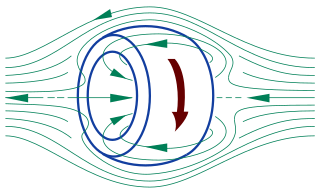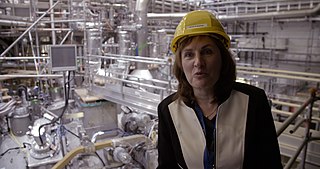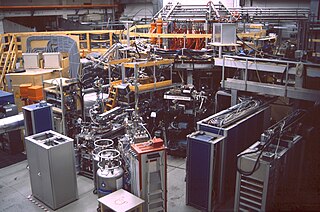Related Research Articles

The stability of a plasma is an important consideration in the study of plasma physics. When a system containing a plasma is at equilibrium, it is possible for certain parts of the plasma to be disturbed by small perturbative forces acting on it. The stability of the system determines if the perturbations will grow, oscillate, or be damped out.

Fusion power is a proposed form of power generation that would generate electricity by using heat from nuclear fusion reactions. In a fusion process, two lighter atomic nuclei combine to form a heavier nucleus, while releasing energy. Devices designed to harness this energy are known as fusion reactors. Research into fusion reactors began in the 1940s, but to date, no design has produced more fusion power output than the electrical power input.

The T-15 is a Russian nuclear fusion research reactor located at the Kurchatov Institute, which is based on the (Soviet-invented) tokamak design. It was the first industrial prototype fusion reactor to use superconducting magnets to control the plasma. These enormous superconducting magnets confined the plasma the reactor produced, but failed to sustain it for more than just a few seconds. Despite not being immediately applicable, this new technological advancement proved to the USSR that they were on the right path. In the original shape, a toroidal chamber design, it had a major radius of 2.43 m and minor radius 0.7 m.

A field-reversed configuration (FRC) is a type of plasma device studied as a means of producing nuclear fusion. It confines a plasma on closed magnetic field lines without a central penetration. In an FRC, the plasma has the form of a self-stable torus, similar to a smoke ring.
The Plasma Physics Laboratory at the University of Saskatchewan was established in 1959 by H. M. Skarsgard. Early work centered on research with a Betatron.
The Enormous Toroidal Plasma Device (ETPD) is an experimental physics device housed at the Basic Plasma Science Facility at University of California, Los Angeles (UCLA). It previously operated as the Electric Tokamak (ET) between 1999 and 2006 and was noted for being the world's largest tokamak before being decommissioned due to the lack of support and funding. The machine was renamed to ETPD in 2009. At present, the machine is undergoing upgrades to be re-purposed into a general laboratory for experimental plasma physics research.
An edge-localized mode (“ELM”) is a disruptive instability occurring in the edge region of a tokamak plasma due to the quasi-periodic relaxation of a transport barrier previously formed during a transition from low to high-confinement mode. This phenomenon was first observed in the ASDEX tokamak in 1981.
Ion cyclotron resonance is a phenomenon related to the movement of ions in a magnetic field. It is used for accelerating ions in a cyclotron, and for measuring the masses of an ionized analyte in mass spectrometry, particularly with Fourier transform ion cyclotron resonance mass spectrometers. It can also be used to follow the kinetics of chemical reactions in a dilute gas mixture, provided these involve charged species.

The Tandem Mirror Experiment was a magnetic mirror machine operated from 1979 to 1987 at the Lawrence Livermore National Laboratory. It was the first large-scale machine to test the "tandem mirror" concept in which two mirrors trapped a large volume of plasma between them in an effort to increase the efficiency of the reactor.
The Spherical Tokamak Experiment is a machine dedicated to plasma studies in low aspect ratio tokamaks. The ETE was entirely designed and assembled at the Associated Plasma Laboratory of Brazil's National Institute for Space Research (INPE).

A ball-pen probe is a modified Langmuir probe used to measure the plasma potential in magnetized plasmas. The ball-pen probe balances the electron and ion saturation currents, so that its floating potential is equal to the plasma potential. Because electrons have a much smaller gyroradius than ions, a moving ceramic shield can be used to screen off an adjustable part of the electron current from the probe collector.

Sibylle Günter is a German theoretical physicist researching tokamak plasmas. Since February 2011, she has headed the Max Planck Institute for Plasma Physics. In October 2015, she was elected a member of the Academia Europaea in recognition of her contribution to research.

A sawtooth is a relaxation that is commonly observed in the core of tokamak plasmas, first reported in 1974. The relaxations occur quasi-periodically and cause a sudden drop in the temperature and density in the center of the plasma. A soft-xray pinhole camera pointed toward the plasma core during sawtooth activity will produce a sawtooth-like signal. Sawteeth effectively limit the amplitude of the central current density. The Kadomtsev model of sawteeth is a classic example of magnetic reconnection. Other repeated relaxation oscillations occurring in tokamaks include the edge localized mode (ELM) which effectively limits the pressure gradient at the plasma edge and the fishbone instability which effectively limits the density and pressure of fast particles.
Jose A. Boedo is an American plasma physicist and a researcher at University of California, San Diego. He is an Elected Fellow of the American Physical Society, which was awarded in 2016 for "his ground-breaking contributions to the studies of plasma drifts and intermittent plasma transport in the peripheral region of tokamaks".
Hartmut Zohm is a German plasma physicist who is known for his work on the ASDEX Upgrade machine. He received the 2014 John Dawson Award and the 2016 Hannes Alfvén Prize for successfully demonstrating that neoclassical tearing modes in tokamaks can be stabilized by electron cyclotron resonance heating, which is an important design consideration for pushing the performance limit of the ITER.
Tihiro Ohkawa was a Japanese physicist whose field of work was in plasma physics and fusion power. He was a pioneer in developing ways to generate electricity by nuclear fusion when he worked at General Atomics. Ohkawa died September 27, 2014 in La Jolla, California at the age of 86.
Guy Laval is a French physicist, professor at the École polytechnique and member of the French Academy of Sciences.

Boris Borisovich Kadomtsev was a Russian plasma physicist who worked on controlled fusion problems. He developed a theory of transport phenomena in turbulent plasmas and a theory of the so-called anomalous behavior of plasmas in magnetic fields. In 1966, he discovered plasma instability with trapped particles.

Wendelstein 7-AS was an experimental stellarator which was in operation from 1988 to 2002 by the Max Planck Institute for Plasma Physics (IPP) in Garching. It was the first of a new class of advanced stellarators with modular coils, designed with the goal of developing a nuclear fusion reactor to generate electricity.
References
- ↑ Mirnov, S. V. (1965). "A probe method for measuring the displacement of the current channel in cylindrical and toroidal discharge vessels". Journal of Nuclear Energy C. 7 (3): 325–328. doi:10.1088/0368-3281/7/3/112. ISSN 0368-3281.
- ↑ McGuire, K.; Hammett, G. (1982). "Analysis of Mirnov oscillations on PDX".
{{cite journal}}: Cite journal requires|journal=(help) - ↑ Tan, I. H.; Caldas, I. L.; Nascimento, I. C.; Silva, R. P. Da; Sanada, E. K.; Bruha, R. (1986). "Mirnov Oscillations in a Small Tokamak". IEEE Transactions on Plasma Science. 14 (3): 279–281. Bibcode:1986ITPS...14..279T. doi:10.1109/TPS.1986.4316542. ISSN 0093-3813. S2CID 12920335.
- ↑ Kikuchi, M. (1986). "A note on the Mirnov signal analysis in tokamaks". Nuclear Fusion. 26 (1): 101–107. doi:10.1088/0029-5515/26/1/009. ISSN 0029-5515. S2CID 122502537.
- ↑ Raju, D.; Jha, R.; Kaw, P. K.; Mattoo, S. K.; Saxena, Y. C.; Team, Aditya (2000-11-01). "Mirnov coil data analysis for tokamak ADITYA". Pramana. 55 (5): 727–732. Bibcode:2000Prama..55..727R. doi:10.1007/s12043-000-0039-8. ISSN 0973-7111. S2CID 120615200.
- ↑ Glasser, A. H.; Greene, J. M.; Johnson, J. L. (1975). "Resistive instabilities in a tokamak". doi:10.2172/4183368. OSTI 4183368.
{{cite journal}}: Cite journal requires|journal=(help) - ↑ Mirnov, S. V.; Semenov, I. B. (1971). "Investigation of the instabilities of the plasma string in the Tokamak-3 system by means of a correlation method". Soviet Atomic Energy. 30 (1): 22–29. doi:10.1007/BF01788387. ISSN 1573-8205. S2CID 124432349.
- ↑ Schittenhelm, M.; Zohm, H. (1997). "Analysis of coupled MHD modes with Mirnov probes in ASDEX Upgrade". Nuclear Fusion. 37 (9): 1255–1270. Bibcode:1997NucFu..37.1255S. doi:10.1088/0029-5515/37/9/I06. ISSN 0029-5515. S2CID 250784804.